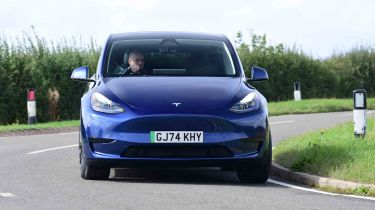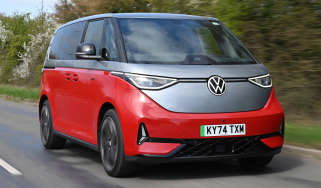Tesla Model Y - Electric motor, drive and performance
The Tesla Model Y is easy to drive, with plenty of straight-line performance, but it’s not particularly fun

If you’re after one of the best all-electric family cars, then the truth is that very few rivals can match the all-round mix of performance and efficiency of the Model Y.
The pick of the range is the base Long Range Rear-Wheel Drive, which not only offers the best range of the three powertrain choices at 373 miles, but is still able to achieve a 0-60mph time of just 5.7 seconds.
The power delivery is linear and predictable, too; while some EVs dump all of their torque to the front wheels instantly, causing clumsy wheelspin, the Model Y instead brings it in gradually, causing a surge of acceleration that’s not unlike driving a very powerful petrol-powered car and moving away from standstill in second gear.
For those with slightly less patience, there’s the Long Range All-Wheel Drive model, which cuts the 0-60mph time down to 4.8 seconds, while the hottest Performance version slashes that number to just 3.5 seconds, and benefits from a range of chassis and brake upgrades to keep everything in check.
| Model | Power | 0-60mph | Top speed |
| Model Y Long Range RWD | 347bhp | 5.7 seconds | 135mph |
| Model Y Long Range AWD (5 seat) | 384bhp | 4.8 seconds | 135mph |
| Model Y Performance | 426bhp | 3.5 seconds | 155mph |
What is the Tesla Model Y like to drive?
Make no mistake, the Model Y isn’t a car for the driving enthusiast – yes, there’s the typically strong EV acceleration, but its steering feels too artificial and its chassis lacks sophistication for those tempted to take a spirited drive down a twisty B-road. That also translates into an unsettled ride, which is a little disappointing.
In town
Driving the Model Y on more urban routes, at lower speeds, is a bit of a mixed bag. Highlights include the braking and motor regeneration, which are brilliantly calibrated - allowing you to bring the Tesla to a limo-like smooth stop with very little effort. However, if you don’t like one-pedal driving, this isn’t the car for you, because there are no other options available. Another slight problem when driving in town is that the turning circle, at over 12 metres, isn’t the greatest for a car of this size.
On A- and B-roads
The Model Y’s rather numb steering feel presents more of an issue at higher speeds. It’s incredibly quick and responsive, which - up to a point - makes the Model Y agile through the corners, but the weighting and feedback are poor, feeling more like the cheap Mario Kart-imitating racing game playable through the car’s touchscreen than it does a physical steering rack.
Used - available now

2023 Tesla
Model Y
41,298 milesAutomaticElectric
Cash £28,000
2023 Tesla
Model Y
30,628 milesAutomaticElectric
Cash £28,000
2023 Tesla
Model Y
24,311 milesAutomaticElectric
Cash £26,300
2023 Tesla
Model Y
12,039 milesAutomaticElectric
Cash £27,300The driving experience is also not helped by the heavy brake regeneration, which means that when entering a corner, it’s tricky to balance the car through a turn. Most drivers will rarely use the actual brakes, but for those occasions when they are needed, a little more firmness to the pedal would make things feel rather more reassuring.
The chassis isn’t that well resolved on the Long Range models; while later cars ride a little softer than earlier Model Ys’ brutally harsh set-ups, there’s still some fidgeting that never goes away. The Performance, which gets a unique suspension set-up, feels much more sophisticated, delivering both better body control and a more compliant ride.
On the motorway
Unfortunately, you’ll find the Model Y transmits plenty of road noise through its fat tyres. It’s among the more noisy cars in this class to drive at high speed as a result. We’re holding out for the revised model, because if its upgrades mirror those applied to the smaller Model 3, they should introduce more soundproofing materials, which delivered a noticeable improvement in refinement for its sibling.
Electric motors, 0-60 acceleration and top speed
There are two drive configurations available for the Tesla Model Y. The entry-level Long Range Rear-Wheel Drive model has a single 342bhp electric motor on the back axle, and this version is capable of 0-60mph in 5.9 seconds on the way to a top speed of 135mph.
Next up is the Long Range Dual Motor model. This adds a second motor to the front axle for a combined output of 384bhp, while the extra traction of four-wheel drive means 0-60mph takes 4.8 seconds. Top speed is the same, at 135mph.
At the top of the range, the Model Y Performance has the same four-wheel drive powertrain as the Dual Motor, but it’s cranked up to 426bhp and is capable of 0-60mph in 3.5 seconds. The top speed is also increased to 155mph.
All cars are responsive from a standstill, and there’s decent mid-range acceleration, especially from the Performance model, while the silent running of the motors means that the Model Y sprints ahead without any sense of drama.










